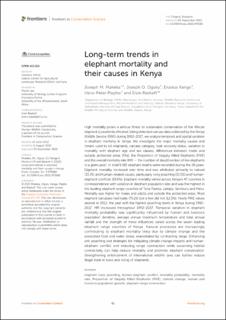| dc.description.abstract | High mortality poses a serious threat to sustainable conservation of the African elephant (Loxodonta africana). Using detected carcass data collected by the Kenya Wildlife Service (KWS) during 1992-2017, we analyze temporal and spatial variation in elephant mortality in Kenya. We investigate the major mortality causes and means used to kill elephants, carcass category, tusk recovery status, variation in mortality with elephant age and sex classes, differences between inside and outside protected areas (PAs), the Proportion of Illegally Killed Elephants (PIKE) and the overall mortality rate (MR — the number of dead/number of live elephants in a given year). In total 9,182 elephant deaths were recorded during the 26 years. Elephant mortality increased over time and was attributed primarily to natural (33.1%) and human-related causes, particularly ivory poaching (31.5%) and human-elephant conflicts (19.9%). Elephant mortality varied across Kenya’s 47 counties in correspondence with variation in elephant population size and was the highest in the leading elephant range counties of Taita Taveta, Laikipia, Samburu and Meru. Mortality was higher for males and adults and outside the protected areas. Most elephant carcasses had tusks (75.1%) but a few did not (12.5%). Yearly PIKE values peaked in 2012, the year with the highest poaching levels in Kenya during 1992-2017. MR increased throughout 1992-2017. Temporal variation in elephant mortality probability was significantly influenced by human and livestock population densities, average annual maximum temperature and total annual rainfall and the strength of these influences varied across the seven leading elephant range counties of Kenya. Natural processes are increasingly contributing to elephant mortality likely due to climate change and the associated food and water stress, exacerbated by contracting range. Enhancing anti-poaching and strategies for mitigating climate change impacts and human-elephant conflict and reducing range contraction while sustaining habitat connectivity can help reduce mortality and promote elephant conservation. Strengthening enforcement of international wildlife laws can further reduce illegal trade in tusks and killing of elephants. | en_US |

